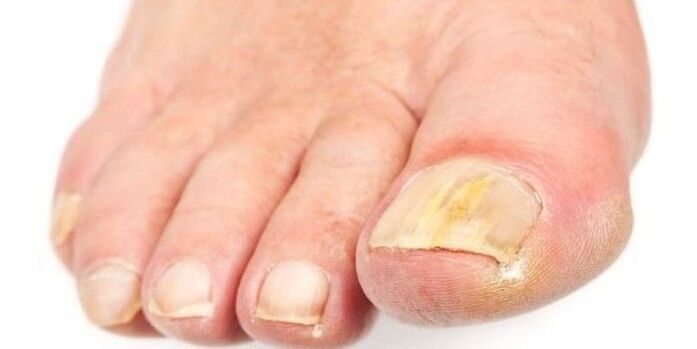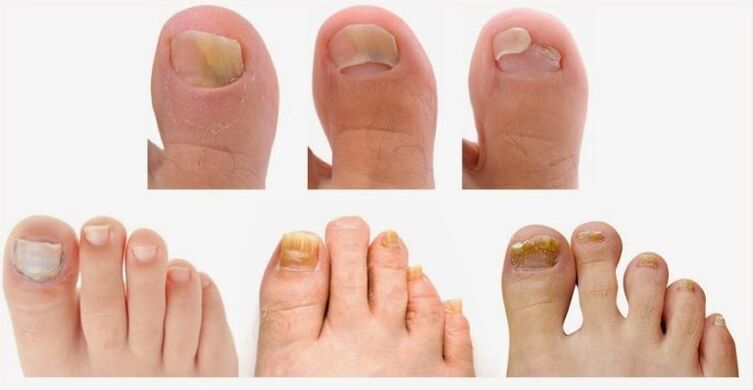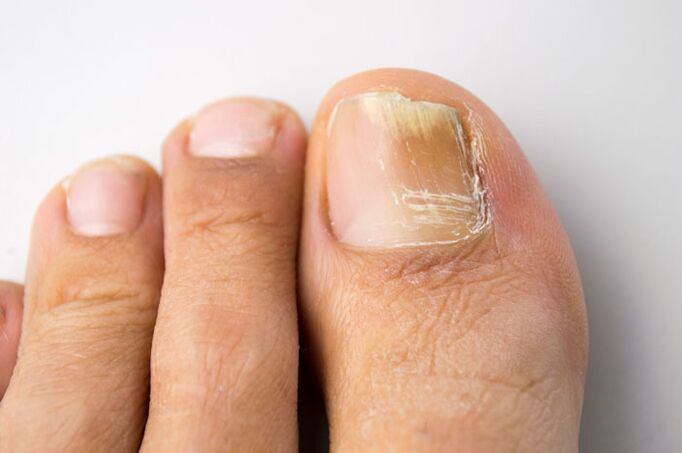Many changes in the legs on the legs can make people think that they have a fungal infection of nails, from a medical point of view, known as onychomycosis. The fungal infection of the nails sometimes makes the condition contagious or is associated with poor hygiene. In fact, up to 10% of all adults have fungal nail infections. This percentage increases to 20% of adults aged 60 and older. In fact, non -normally looking nails can be caused by a number of conditions, including, but not limited, fungal infection. There are many other reasons why the nails can look different.

Treatment of nail fungus
Onychomycosis is a fungal infection, usually caused by a special type of fungus, known as Dermatophyte. Since most of these infections are relatively superficial, it would seem that current procedures should work well. This is not so, because the nail is relatively impenetrable. Examples of states that are often mistaken for fungal nails include yellow (onycholysis), hematoma, green nails (caused by pseudomonas bacteria), bones (usually associated with psoriasis), nail infection (steamonichia) and late injury.
What other conditions can be taken for fungal nails?
Here are some other conditions that may be instead of fungal nails:
Lines and ridges: they are common and can be considered normal. They can worsen during pregnancy. A large groove in the center of the nail can be caused by injuries. Some people may notice these changes after chemotherapy.
Senile nails: with age, the nails become fragile and develop the ridges and the separation of the nail layers at the end of the nail. To avoid this, it is necessary to use special solutions and baths.
White or yellowish nails can occur due to ONYCHOLYSIS. This means separating the plate from the nail base. The color that the form is the air under the nail. The treatment consists in cutting the plate briefly, not to clean under it and polish. If you need to hide the color, you need to wait for two to three months. Constant Onkelos can make nails susceptible to fungal infection. Red or black plates due to hematoma or blood under the nail, as a rule, occur from injury. If there is a black spot under the nail, which is not caused by injury, you should visit a dermatologist or orthopedist to make sure that this is not melanoma (the type of skin cancer associated with pigmented cells). Simple biopsy can exclude malignancy (cancer).
Green plates can be caused by Pseudomonas bacteria, which grow under the nail, which is partially separated from the nail base. This infection can cause an unpleasant odor of nails. The treatment consists in cutting the nails briefly every four weeks, do not clean, polish if you need to hide the color, and wait for two to three months. It is also recommended to avoid soaking the plates in any water (and thoroughly dry the legs after bathing. If the problem has not disappeared, there are drug prescriptions for treatment that the doctor prescribes. Nails affected by psoriasis can also be brown.
Edema and redness of the skin around the nail are called Paronychia. This is an infection of the skin in the bottom of the nail (cuticle). If the infection is acute (has a quick start), it is usually caused by bacteria. He can react to warm baths, but it is better not to self -medicate, but to see a doctor immediately. Chronic paronichia occurs when the cuticle is inflamed or irritated over time. Sometimes fungi will use damaged skin and infect it. Therapy begins with the fact that the skin remains dry and excreted from the water. If the problem does not disappear, you should consult a doctor. Antibiotics are not often used, but may be required with a serious infection.

Chronic nail injury can lead to damage to nails, which can very much resemble fungal nails. Some injuries can cause constant changes that can imitate the appearance of fungal nails. Microconidii Trichophyton fungus, which live in the soil and can lead to fungal infections of the skin, hair or nails.
What causes fungal infections, and what are some risk factors?
In normal healthy people, fungal infections of nails are most often caused by a fungus, which falls into moist areas. Communal showers, such as in the gym or swimming pools, common sources. The transition to nails that use inadequate cleaning of tools (for example, clipper, fillets and feet baths) in addition to life with family members that have fungal diseases, are also risk factors. It was proved that athletes are more susceptible to the fungus of the nail.
It is assumed that this is due to the fact that the densely tight -fitting, sweaty boots associated with the repeating injury of nails on the legs. The presence of sports loads makes it more likely that the fungus will infect the nails on the legs. The repeating injury also weakens the plate, which makes it more susceptible to fungal infection. These include everything that worsens the immune system can make a person prone to infection with a fungus. These include conditions such as AIDS, diabetes, cancer, psoriasis or the adoption of any immunosuppressants, such as steroids.
Are fungal nails contagious?
Although the fungus should be obtained somewhere, it is not very contagious. It is so common that to find more than one person in a family who has this is nothing more than an accidental coincidence. The fungus can be transmitted from person to person, but only with constant intimate contact.
What are fungal symptoms and signs of nails?
Although fungal nails are usually cosmetic problems, some patients experience pain and discomfort. These symptoms can be aggravated by shoes, activity and improper nail trim. There are many types of mushrooms that can affect the nails. Nevertheless, the most common, however, is called Trichophyton Rubrum. This type of fungus tends to infect the skin (known as Dermatophyte) and is manifested in the following specific methods. It begins at the ends of the nails and raises the plate up: it is called "distal onychomycosis. "This is the most common type of fungal infection of nails in adults and children (90% of cases).

It is more common in the toes, the thumb is usually the first to influence. Risk factors include elderly age, swimming, sports loads, psoriasis, diabetes, family members with an infection or a depressed immune system. Usually it begins as a colorless area on the corner of the thumb and slowly spreads to the cuticle. It is often accompanied by ONYCHOLYSIS. The most common cause is T.
It begins at the base of the nail and raises a nail up: it is called the "proximal tendon onychomycosis". This is the least common type of fungal damage (about 3% of cases). It looks like a distal type, but begins with a cuticle (base of the nail) and slowly spreads to the tip of the nail. This type is almost always found in people with a damaged immune system. It is rarely possible to see fragments under the tip of the nail with this condition, unlike the distal Sundrily Onychomycosis. The most common cause is the mold T. Rubrum and Dermatophyte.
Yeast Onychomycosis: This type is caused by yeast called Candida, and not the Trichophyton fungus, named above. This is more common in nails and is a common cause of fungal nails. Patients can be associated with Paronychia (cuticle infection). Candida can cause yellow, brown, white or thickened nails. Some people who have this infection also have fungi in the mouth or chronic paronichia), which is also infected with pores. White surface onychomycosis: in this state of a nail, a doctor can often clean white powder material on the upper part of the nail plate. This condition is most common in tropical environments and caused by a well -known fungus and Trihofitii Managoff.
What tests are used by health specialists to diagnose fungal nails?
It was shown that only one physical examination is an unreliable method of diagnosing fungal nails. There are many conditions that can make the nails look damaged, so even doctors have difficult time. In fact, studies have shown that only about 50% - 60% of cases of abnormal appearance of nails were caused by a fungus. Therefore, laboratory tests are almost always indicated. Some insurance companies may even ask for a confirmation of a laboratory test for diagnostics to cover an antifungal medicine. A sample plate is obtained either by cutting the nail, or by drilling a hole in it. This piece is sent to the laboratory where it can be painted, cultivated or tested using PCR (to identify the genetic material of organisms) to identify the presence of the fungus.
If the negative result of the biopsy is accompanied by a high clinical suspicion, for example, the plates that are ragged, bleached, thickened and loose, this requires a second test due to the prevalence of false negative results in these tests. Most drugs used to treat nail fungus have side effects, so you should get acquainted with contraindications.

What specialists treat the nail fungus?
There are several doctors who can provide treatment of the nail fungus. The attending physician, dermatologist or orthopedist can treat nail fungus. Any of these doctors can provide a proper diagnosis and prescribe drugs specific to a fungal infection. A orthopedic or a dermatologist can shake the upper layer of the nail or even remove part of the nail.
What treatment of fungal nails is required?
Creams and other relevant drugs are traditionally less effective against nail fungus than oral medicines. This is due to the fact that the nails are too complicated for the penetration of external applications. It is also difficult to adhere to local treatment schemes. Often, these drugs require daily applications during the period of time up to one year to see the results. One of the main advantages of local treatment is the minimum risk of serious side effects and interaction with drugs compared to oral therapy.
Coral antifungal therapy operates in about 50-75% of cases, depending on the drug. This can take from nine to twelve months to make sure that it worked or not, because this is how long you need to build up the nail. Even when therapy works, the fungus can return in about 20-50% of cases. Currently, oral antifungal therapy is considered the best tool for treating fungi on the legs due to higher cure rates and a shorter duration of treatment compared to local therapy.
There are several innovative treatment methods that are still checked:
- Laser therapy or photodynamic therapy use the use of light -active agents on a plate, followed by a brilliant light of the corresponding wavelength on the nail.
- The use of electric current to help the absorption of relevant antifungal drugs into a nail: it is also called iontophores.
- The use of a special nail polish that changes the nail microclimate to make it inhospitable for the growth of the fungus: if it works, it can be an inexpensive way to treat this problem in the future.
One way to finally get rid of the nail fungus is the operation. Surgical treatment of onhomycosis includes nail removal. Nevertheless, this often only provides temporary relief, and relapse is common if additional antifungal drugs (oral or local) are not used at the same time. However, surgical removal can be justified if the touched nail is associated with other factors such as injury or infection.
Is it possible to prevent the appearance of nail fungus on the legs?

Since the fungus really flourishes in warm wet areas (for example, sweaty legs), there are certain areas that should be avoided or used with caution. It is assumed that showers, locker rooms and pools are sources of fungus, although there are no studies confirming this fact.
Nail varnish and acrylic nails also make a plate less "breathing" and make it more susceptible to fungal infection. Mushrooms are everywhere - in the air, dust and soil. Hygienic measures, such as spraying socks and shoes, are reasonable, and perhaps these measures can even help a little. Nevertheless, avoiding dense, not breathing boots or gender for sports facilities, it may well turn out to be the best prevention. Daily washing of the legs and drying between the fingers can help prevent the nail fungus. The fungi are transferred to pets, such as cats and dogs. However, they do not often cause a disease.
How to determine nail fungus?
Treatment of fungal nails can be difficult, and can take up to 18 months. Reinfection and reinfection are common (re -infection frequency of 40% -70%). An attempt to remove or change risk factors, if possible, is important to prevent re -infection. People who have medical diseases who predispose them to fungal lesions can be cured even longer from the fungus.
Tips for the prevention of treatment of nail fungus
The fungus causes only 50% -60% of non -normally inflating nails. It is difficult to immediately note the difference between the various reasons for the bleached nails (even for doctors). Onychomycosis is often not treated. The reasons for which medical treatment is necessary mainly with the injuries of the skin of the legs or nails.























